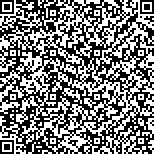| 引用本文: |
王珊珊,白俊杰,于雪,范盎然,杜庆红,李卫红.基于NLRP3信号通路探讨清开灵对肝纤维化大鼠的影响及作用机制[J].湖南中医药大学学报,2023,43(9):1561-1569[点击复制] |
|
| |
|
|
| 本文已被:浏览 1635次 下载 881次 |
| 基于NLRP3信号通路探讨清开灵对肝纤维化大鼠的影响及作用机制 |
| 王珊珊,白俊杰,于雪,范盎然,杜庆红,李卫红 |
| (北京中医药大学, 北京 100029;北京京煤集团总医院, 北京 102300;北京中医药大学, 北京 100029;西藏藏医药大学, 西藏 拉萨 850000) |
| 摘要: |
| 目的 明确清开灵口服液对CCl4大鼠的抗肝纤维化作用,并基于NOD 样受体热蛋白结构域3(NOD-like receptor protein domain 3, NLRP3)炎症小体通路揭示其抗肝纤维化的机制。方法 44只SD大鼠随机分为空白组、模型组、清开灵口服液组(QKL组),应用CCl4灌胃的方法建立中毒性肝纤维化大鼠模型,设置4周与8周两个时间点。实验结束后,检测各组大鼠肝、脾指数;HE染色和Masson染色观察肝组织结构变化与胶原纤维增生情况;检测血清天冬氨酸氨基转移酶(aspartate aminotransferase, AST)、丙氨酸氨基转移酶(alanine aminotransferase, ALT)、总胆红素(total bilirubin, T-BIL)、羟脯氨酸(hydroxyproline, HYP)、谷胱甘肽过氧化物酶(glutathione peroxidation, GSH-Px)含量;ELISA法检测肝组织肿瘤坏死因子-α(tumor necrosis factor-α, TNF-α)、白细胞介素-1β (interleukin-1β, IL-1β)水平;免疫组化检测肝组织α-平滑肌肌动蛋白(α-smooth muscle actin, α-SMA)的表达;采用Western blot、RT-PCR法检测肝组织NLRP3、衔接蛋白凋亡相关斑点样蛋白(adaptor protein apoptosis-related dot-like protein, ASC)、半胱氨酸天冬氨酸蛋白水解酶-1(Caspase-1)、α-SMA的蛋白和基因的表达水平。结果 与空白组相比,4周与8周模型组肝脾指数及AST、ALT、T-BIL、HYP含量均明显升高(P<0.01)、GSH-Px活力显著下降(P<0.01),IL-1β和TNF-α含量明显升高(P<0.01),α-SMA、NLRP3、ASC、Caspase-1的蛋白及基因表达水平均明显增加(P<0.05)。HE和Masson染色显示模型组肝组织形态结构紊乱,炎症细胞大量浸润,肝脏纤维组织增生更加明显。与模型组相比,同期清开灵组均可明显降低肝脾指数及血清AST、ALT、T-BIL含量和HYP含量(P<0.05),提高GSH-Px活力(P<0.05,P<0.01),抑制TNF-α、IL-1β合成(P<0.01,P<0.05),减轻肝组织结构紊乱和炎细胞浸润,抑制胶原纤维增生,抑制α-SMA蛋白表达(P<0.05),NLRP3、ASC和Caspase-1在蛋白和基因水平表达呈不同程度降低(P<0.05,P<0.01)。结论 清开灵口服液可显著抑制CCl4导致的大鼠肝纤维化,提高肝脏抗氧化能力,改善肝功能,缓解炎症,其机制可能与抑制星状细胞活化、抑制NLRP3炎症小体通路活化相关。 |
| 关键词: 清开灵口服液 炎症 肝纤维化 肝星状细胞 NLRP3炎症小体 四氯化碳 |
| DOI:10.3969/j.issn.1674-070X.2023.09.003 |
| 投稿时间:2023-05-31 |
| 基金项目:西藏自治区藏医药管理局级科技专项(JJKT2020006);西藏自治区科技厅重点研发项目(XZ202201ZY0019G)。 |
|
| Effects and mechanisms of action of Qingkailing Oral Liquid on rats with liver fibrosis based on NLRP3 signaling pathway |
| WANG Shanshan,BAI Junjie,YU Xue,FAN Angran,DU Qinghong,LI Weihong |
| (Beijing University of Chinese Medicine, Beijing 100029, China;Beijing Jingmei Group General Hospital, Beijing 102300, China;Beijing University of Chinese Medicine, Beijing 100029, China;University of Tibetan Medicine, Lhasa, Tibet 850000, China) |
| Abstract: |
| Objective To clarify the anti-liver fibrosis effects of Qingkailing Oral Liquid on CCl4 rats and to reveal the mechanism of anti-liver fibrosis based on NOD-like receptor protein domain 3 (NLRP3) inflammasome pathway. Methods Forty-four SD rats were randomly divided into blank group, model group, and Qingkailing Oral Liquid group (QKL group). The rat model of toxic liver fibrosis was established by CCl4 gavage, with two time points set at 4 weeks and 8 weeks. After the experiment, the liver and spleen indexes were measured in each group of rats; HE staining and Masson staining were used to observe the changes in liver tissue structure and the hyperplasia of collagen fibers. The content of aspartate aminotransferase (AST), alanine aminotransferase (ALT), total bilirubin (T-BIL), hydroxyproline (HYP), and glutathione peroxidase (GSH-Px) in serum were determined; the levels of tumor necrosis factor-α (TNF-α) and interleukin-1β (IL-1β) in liver tissue were examined by ELISA; the expression of α-smooth muscle actin (α-SMA) in liver tissue was checked by immunohistochemical (IHC) method; the protein and gene expression levels of NLRP3, adaptor protein apoptosis-related dot-like protein (ASC), cysteinyl aspartate specific proteinase (Caspase-1), and α-SMA were measured by Western blot and RT-PCR. Results Compared with the blank group, the liver and spleen indexes and the content of AST, ALT, T-BIL, and HYP in the model group at 4-week and 8-week significantly increased (P<0.01), the GSH-Px activity significantly decreased (P<0.01), the content of IL-1β and TNF-α significantly increased (P<0.01), and the protein and gene expression levels of α-SMA, NLRP3, ASC, and Caspase-1 significantly increased (P<0.05). HE and Masson staining showed disorganized structure in liver tissue, massive infiltration of inflammatory cells, and more obvious liver fibrous tissue hyperplasia. Compared with the model group, the liver and spleen indexes and the content of AST, ALT, T-BIL, and HYP in the QKL group significantly reduced (P<0.05), the activity of GSH-Px significantly increased (P<0.05, P<0.01), and the synthesis of TNF-α and IL-1β was inhibited (P<0.01, P<0.05), the structural disorder of liver tissue and the infiltration of inflammatory cells were reduced, the hyperplasia of collagen fibers and the protein expression of α-SMA were inhibited (P<0.05), and the protein and gene expression levels of NLRP3, ASC, and Caspase-1 decreased in different degrees (P<0.05, P<0.01). Conclusion Qingkailing Oral Liquid can significantly inhibit CCl4-induced liver fibrosis in rats, enhance antioxidant capacity of liver, improve liver function, and relieve inflammation. The mechanism may be related to inhibiting the activation of stellate cells and NLRP3 inflammasome pathway. |
| Key words: Qingkailing Oral Liquid inflammation liver fibrosis hepatic stellate cells NOD-like receptor protein domain 3 inflammasome carbon tetrachloride |
|

二维码(扫一下试试看!) |
|
|
|
|




